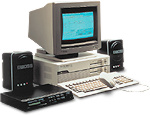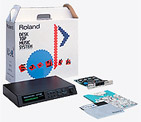1983: MIDI is standardized after two years of discussion.
1984: Roland launches the MIDI processing unit MPU-401, designed to connect MIDI devices with a computer. The MPU-401 is a box with its own power supply that is connected to the computer via a card or cartridge. Interface kits for eight computer systems are available: NEC PC-88, NEC PC-98, Fujitsu FM7, Sharp X1, MSX, Apple II, Commodore 64, and IBM PC.
1987: Roland launches the LA (Linear Arithmetic) family of synthesizers. At the bottom end is the MT-32, designed for hobby musicians and garage bands.
1988: With the fourth game in the King’s Quest series, The Perils of Rosella, Sierra introduces a new game engine, Sierra’s Creative Interpreter (SCI). The new engine supports EGA graphics and three music devices: The AdLib Music Card, Creative Labs’ Game Blaster, and the Roland MT-32. They also sell these three devices. If you buy an MT-32, you get two games for free.
1989: Roland launches the “Computer Music” series of synthesizers. They are designed for use with a computer only and have no LED display and no controls but a volume knob. Of these, the CM-32L is an improved version of the MT-32. It has less noise and some extra sound effects for games. For NEC PC-98, Apple II and IBM PC it is also available together with the MPU on a single card, the LAPC (LAPC-N, LAPC-A, LAPC-I respectively).
1991: The General MIDI (GM) standard is published. Still in the same year, Roland adds the GS extension (expanded variously as General Standard or General Sound) and presents a device that supports both, the SC-55 Sound Canvas. Unlike the MT-32, the Sound Canvas is a wavetable device and not programmable. Other companies soon produce GM devices as well, often as daughterboards for the Soundblaster cards that are getting more and more popular.
1992: Dune II is one of the first, or maybe even the first, game to support the new Sound Canvas.


